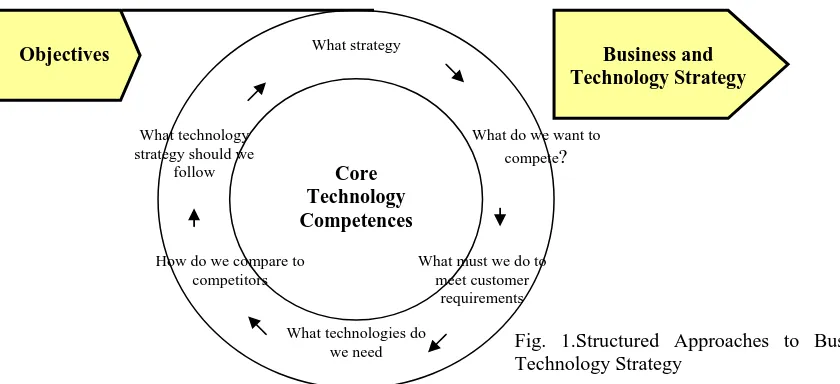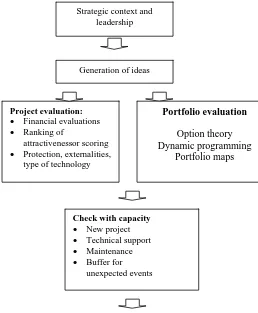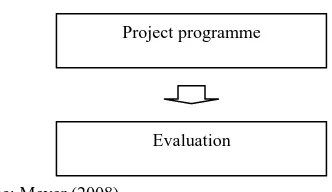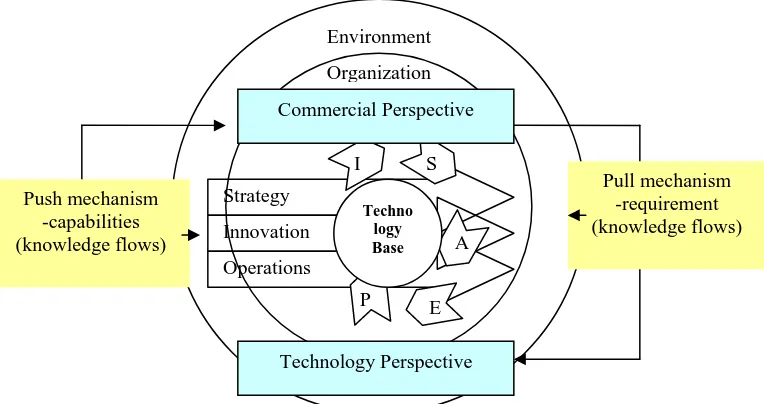A Study on Business and Technology Strategy in Achieving Business Objectives
Abd. Rahman Ahmad, Dr. Alina Shamsuddin, Maimunah Ali, Harris Md Nor & Ahmad Kaseri Ramin
Faculty of Technology Management Universiti Tun Hussein Onn Malaysia
86400 Batu Pahat, Johor arahman@uthm.edu.my
Abstract
In today’s fast-paced and rapidly changing business environment, companies has deeply modified their strategies to integrate technology into the business planning process. Technologies are now everywhere in the firm’s value chain. Thus, it is necessary for firms to adapt their strategic process as technology is pervasively important as part of business function. This implies the need to study a technology strategy that link technology with business objective. In this paper, the researchers will review a structured approach to business and technology strategy. The process includes study a framework that serve as a guidance to organizations enabling them to analyse the technology needs for a business. Therefore, managers must be aware of the strategic importance of technology in delivering value and competitive advantage to their companies. Among the awareness are deciding which technologies support the strategic objectives, identifying companies strengths and weaknesses, establishing technology priorities, and finally deciding strategic actions.
Keywords: Technology, Business Strategy
1. Introduction
In today’s fast-paced and rapidly changing business environment, companies has deeply modified their strategies to integrate technology into the business planning process. Technologies are now everywhere in the firm’s value chain. Thus, it is necessary for firms to adapt their strategic process as technology is pervasively important as part of business function. This implies the need to develop a technology strategy that link technology with business objective. In this paper, the researchers will review a structured approach to business and technology strategy.
Establishing and maintaining the linkages between technological resources and company objectives is of vital importance and represents a continuing challenge for many firms. This requires effective strategic processes of particular importance are the dialogue and understanding that needs to be established between the commercial and technological functions in the business.
The process includes designing a framework that serve as a guidance to organizations enabling them
to analyze the technology needs for a business. Therefore, managers must be aware of the strategic importance of technology in delivering value and competitive advantage to their companies. Among the awareness are deciding which technologies support the strategic objectives, identifying companies’ strengths and weaknesses, establishing technology priorities, and finally deciding strategic actions.
According to Floyd (1997), in particular of that, there are approaches for:
i. Deciding which technologies you need to support the strategic objectives of your business.
ii. Determining competitive strengths and weaknesses in the technologies matter
iii. Setting corporate technology priorities
iv. Deciding on strategic actions to strengthen your position
2. Strategic Management Process
The terms “strategic management” and “strategic planning” are often used in the organization. Even though the terms are formally known, but in fact they are not the same. According to Poister (2003), strategic planning is the process of clarifying mission and vision, defining major goals and objectives, and developing long-term strategies for moving an organization into the future in a purposeful way and ensuring a high level of performance in the long run and the strategic management, in contrast, is the larger process that is responsible for the development of strategic plans, the implementation of strategic initiatives, and the ongoing evaluation of their effectiveness.
Sometimes the strategic management is used to refer to the three (3) important stages in strategic management process that are strategy formulation, strategy implementation and strategy evaluation and the purpose of strategy planning is referring only in strategy implementation.
According to David (2001), the strategic management process consists of three important stages. The first stage is the strategy formulation. At this stage the organization develop a vision, mission, identifying an organization’s strengths, weaknesses, opportunity and threats (SWOT), establishing the short and long term objectives, generating alternative strategies and choosing particular strategies to pursue. At this stage the organization may look at the issues such as what new business to enter, how to allocate resources, whether to expend operations and on how to enter the international market.
The second stage involves the strategy implementation. After strategies are formulated, they must be implemented. This process is known as action strategy. This requires the organization to establish objectives, devise policies, motivate employees, and allocate resources. The action involves developing a strategy-supportive culture,
create budgets, developing and utilizing information system, and linking employee compensation to organizational performance (David, 2001).
A strategy is only as good as its implementation. However the processes are not as simple as plan. The challenge is that the organizations have to face the barriers to stimulate employees throughout an organization to work with pride and enthusiasm toward achieving stated objectives.
The final stage in strategic management process is the strategy evaluation. Organization must determine what actual performance is by obtaining information about it. Strategy evaluation includes three basic activities. The first activity is examining the underlying bases of organization strategy. Next, comparing expected results with actual results and finally taking corrective action. According to David (2001) the strategy evaluation becoming increasingly difficult today because of the following trends:
i. A dramatic increase in the environment’s complexity
ii. The increasing difficulty of predicting the future with accuracy
iii. The increasing number of variables iv. The rapid rate of obsolescence of even the
best plans
v. The increase in the number of both domestic and world events affecting the organization
vi. The decreasing time span for which planning can be done with any degree of certainty
3. Structured Approach to Business and
Technology Strategy
Floyd (1997) has developed a framework linking business objectives with technology as shows in
Figure 1.
Objectives
Core Technology Competences
What strategy
What do we want to compete?
What must we do to meet customer
requirements What technologies do
we need How do we compare to
competitors What technology strategy should we
follow
[image:2.595.69.489.589.781.2]Business and Technology Strategy
Based on the figure, the structured approaches to business and technology strategy begin with the development of objective. Objectives should be quantitative, measurable, realistic, understandable, challenging, hierarchical, obtainable, and congruent among organizational units. Each objective also should be associated with a time line.
Objectives are commonly stated in terms such as growth in assets, growth in sales, profitability, market share, degree and nature of diversification, and so on.
Long-term objectives are needed at the corporate, divisional, and functional levels in an organization. They are an important measure of managerial performance.
Besides that, the organization also needs to identify the strategy that fit with the current business environment. These includes identify the technology, competitors, products and services. Its includes the internal and external environment. Then organization can link the business and the technology strategy in the organization.
According to Burgelman et. all (2001) technology is a resource that are very important in organizations. Apart from that, managing technology is a basic business function. Vernet & Mohammed Reza Aasti (1999) defined technology strategy as organization priority in technology development that includes technology sourcing, research and development, capital venture in technology development, technology alliance and staff training and development.
Vernet & Mohammed Reza Aasti (1999) develop a model to shows the relationship between technology strategy and business strategy in a firm overall strategic objectives.
[image:3.595.299.557.476.789.2]Source: Vernet & Mohammed Reza Aasti (1999)
Fig. 2: Two directions in bridging the technology strategy and the business strategy
The overall strategic are based on technology competencies to create competitive advantage in
the organization. It is very important for the firm to establish the objective that at the end will support overall strategy especially in the technology.
Most of the company seeks for new competitive environment by taking different approach to strategy development. They implement technology-driven business strategy and creates new business model based on their company need.
A core competency can take various forms, including technical/subject matter know how, a reliable process, and/or close relationships with customers and suppliers. Technology competencies are engaged at the outset, planning and prototyping can occur earlier. Companies can engage in strategy prototyping, testing a variety of potential strategies before a particular course is set. With this iterative, learning-based approach, prototyping takes on a higher purpose, exploring a spectrum of strategic possibilities, not just validating a selected strategy's feasibility. Strategic planning is not anchored to a calendar, but is evaluated and revised to take advantage of insights gleaned from new learning and changes in the technology context.
[image:3.595.85.272.556.698.2]Meanwhile according to Meyer (2008) in developing a technology strategy organization need a clear direction. This is very important so that the organization can tailor the overall of organization strategy.
Figure 3 explain the framework for organization to determent and implement technology strategy
Strategic context and leadership
Project evaluation: • Financial evaluations • Ranking of
attractivenessor scoring • Protection, externalities,
type of technology
Generation of ideas
Check with capacity • New project • Technical support • Maintenance • Buffer for
unexpected events
Portfolio evaluation
Option theory Dynamic programming
Source: Meyer (2008)
Fig. 3: A simplified description of technology strategy
From the framework above, we can see that the determination and implementation of a technology strategy is embedded in an organization where there is clear leadership that sets an overall strategic context. Such an organization may create the conditions where creativity can blossom and where market and user information may meet the technological capabilities developed within the organization, leading to the generation of lots of ideas.
Normally, such an organization will have an overload of ideas and one of the essential tasks in the determination of the technology strategy is to evaluate project on their own merits as well as their contribution within the portfolio. Projects thus selected are prime candidates for investment. But in order to succeed, those investment opportunities need to be checked with the available capacity of the technology organization.
The technology strategy needs to be tailored to the overall strategy of the organization. Clear vision is required defined by the leadership of the organization to create an environment. The leadership needs to set the goals, what kind of business does the firm want to be in and how do you want to position the firm via the competition. By doing so it also defines what should and should not be pursued as innovation projects. A clear vision is the best way to help to define the portfolio of projects and the criteria that you need to use to evaluate new opportunities. A good vision that can enable the development of a technology strategy should live up to two conditions: it has to combine a long-term view with concrete short-term goals and it should not be too constraining. Technology strategy needs to stretch the organization beyond its comfort zone.
4. Linking Technology into Strategies
The developments of technology strategy should initiate at corporate level. It consists of strategic
element such as the vision, plans and business needs and then translates it into a realistic, objective, deliverable corporate strategy for planning process.
Technology is a critical tool to support business strategy. Technology can play in shipping business strategy. In the increasingly unstable business environment, the process of finding a solution able to resolve the technological issue and strategic issue has been describe as a journey into the unknown. To survive the journey, innovation is becoming crucial.
Therefore it is important for the organization to identify effective integration of technology and strategy planning. The development of corporate strategy is the important stage in integrating the idea. At this point, organization will look into resource that available and try to link with the activities.
To understand the linking activity organization must look into factors that affect the strategy. Grant (1991) defined strategy as the matching process for an organization which involves internal and external environment. Technology strategy is generally formed by the systematic process for creating, acquiring, disseminating, leveraging and using knowledge for the competitive advantage and to achieve organizational objectives.
Integration between internal and external resources requires organization to match internal strengths, and weaknesses and external opportunities and threats. It is important for the organization to undertake the strategy initiative by evaluating the environment in order to understand what technology strategy should be managed and performance. Organization that is capable to manage technology strategy successfully will also able to reflect the internal and external competitive strategy.
From the internal and external environment, organization needs to develop the strategy and information of today by using SWOT analysis. The purpose is to link between the internal and external environment.
Part from that, Farrukh, Phaal & Probert (2003) has been develop knowledge and resource based concepts in technology management and builds on a process perspective. The purpose of the framework is to support the understanding of how technological and supporting technology in the context of internal and external environment. Project programme
Source: Farrukh, Phaal & Probert (2003)
Fig. 4: Technology Management Framework
The technology processes such as identification (I), selection (S), acquisition (A), exploitation (E), and protection (P).
Conclusion
Technology and business strategy have a very strong connection. If the companies be short of of technology, business strategy cannot be accomplished. However, even many of the firms that have successfully linked business and technology strategy fail to recognize the link between effective intellectual capital strategy and both business and technology strategy.
References
Andriole, S., J.,(2006). The Collaborate/Integrate Business Technology Strategy. Communications of The ACM May 2006/Vol. 49, No. 5
Bellaver, R.F., & Lusa, J.M., (2002). Knowledge Management Strategy and Technology. Artech House: Boston.
Burgelman, R.A., Maidique, M., A., & Wheelwright, S.C., (2001). Strategic Management of Technology and Innovation. McGraw-Hill: Boston.
Diwan, P., (1999). Productivity & Technology Management. Golden Books Centre: Kuala Lumpur
Floyd, C., (1997). Managing Technology for Corporate Success. Gower Publishing Limited: USA.
Hayes, R., et al. (2005). Operation, Strategy, and Technology: Pursuing the Competitive Edge. Wiley: United States of Amerika
Grant, R.M., (1991), The Resource Based Theory of Competitive Advantage: Implications For Strategy Formulation, California Management Review, Vol. 33 No.3, pp.114-35.
Louis Raymond, François Bergeron (2008). Enabling the Business Strategy of SMEs through E-Business Capabilities (A Strategic Alignment Perspective)
Meyer, D A., (2008). Technology Strategy And China’s Technology Capacity Building. Journal of Technology Management in China. Vol. 3 No. 2, 2008 pp. 137-153
Papp, R., (2001). Strategic Information Technology: Opportunities for Competitive Advantage. Idea Group Publishing. UK
Phaal, R., Farrukh, C and Probert, D., (2001). Technology Roadmapping: Linking Technology Resources to Business Objectives. Centre for Technology Management, University of Cambridge Institute for Manufacturing, Mill Lane,
Cambridge, CB2 1RX, UK
Willyard, C.H. and McClees, C.W. (1987), ‘Motorola’s technology roadmap process’,
Research Management, Sept.-Oct., pp. 13-19.
Vernet, M., & Mohammaed Reza Arasti (1999). Linking Business Strategy to Technology Strategies: A Prerequisite to the R&D Determination. International Journal Technology Management, Vol. 18, No. 3/4 1999.
Environment
Organization
Strategy
Innovation
Operations
I S
A
E P
Push mechanism -capabilities (knowledge flows)
Pull mechanism -requirement (knowledge flows) Commercial Perspective
Technology Perspective Techno



